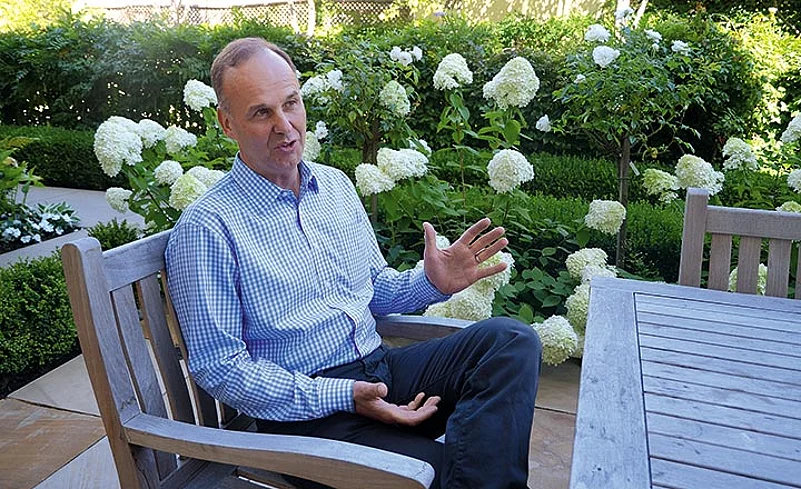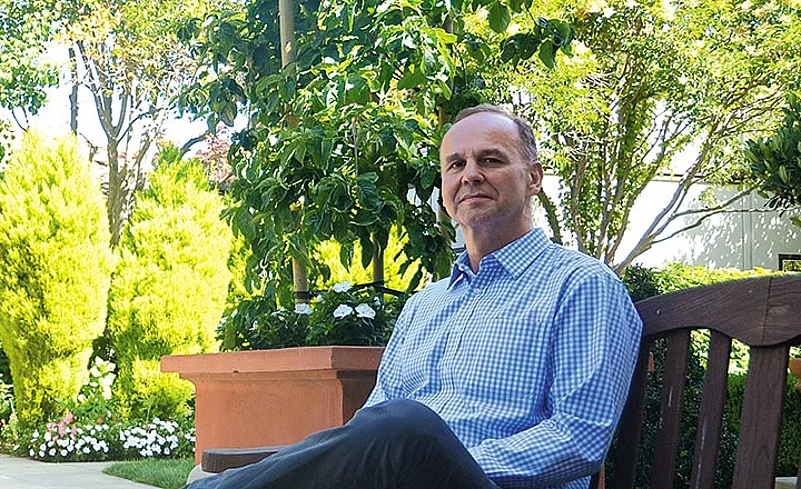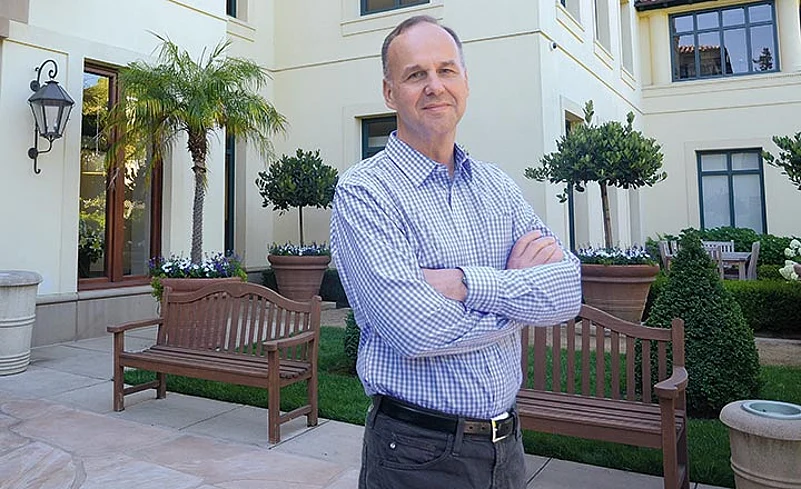Palo Alto/ July 12, 2017
Coming from a military family, it was clear to Paul Madera in the 8th grade that he wanted to become an Air Force pilot — he has flying high ever since. In the world of venture capital, Madera is the quintessential outsider and Meritech Capital of which he is a co-founder must be the leanest firm in Silicon Valley despite its multi-billion dollar book. Till recently it had only six partners and it just hired its first non-partner. When Madera entered the business in 1999, it was a great time to raise money but a terrible time to invest as the events unfolding in 2000 would prove. Madera has put the learning to good use and has made many successful investments, the most famous being that in Salesforce and Facebook. He is still a big believer in Facebook and holds it in his personal portfolio. The sage-like Madera is a regular on the Forbes Midas List but has deliberately stayed low profile in his quest to find great late-stage investments.
Let’s begin with your career switch — from being a fighter pilot to eventually becoming a venture capitalist.
It’s been an interesting journey. During my stint in the Air Force, I did some really interesting things, like being one of the earliest guys to fly the F-16. Though I did everything right through the Air Force, I saw myself doing much of the same thing over the next ten years. Since I was single, it was easier to make big decisions. So, I decided to apply to Business School, though I didn’t really know what a B-School was. Since my family had been in the military, I didn’t really know much about people in business either. But I thought, if I get into a good B-School, I will go for it. One night, I wrote applications to three B-Schools and my application got accepted by Stanford. I learnt a lot about business at Stanford. Then, of course, I headed to New York to start out with an investment bank. At the time, investment banking was, perhaps, the most prestigious thing a B-School grad could do. It’s certainly not that way today! Investment banking turned out to be very interesting for me, particularly engaging with smaller companies. And then that one little window gave me a chance to move out into the venture world.
Are there any personal attributes and characteristics that you imbibed during your tenure as a fighter pilot that had an enduring impact in the way you think and also contributed to your success?
Yes, absolutely. For one, I am calm in situations where others get excited. Maybe it’s because while flying every pilot faces situations that can turn unfavourable. So, after a while you learn that getting excited doesn’t help in you anything. Hence, in situations where companies are facing difficulties or things are going wrong, I am very calm and focus on thinking about the best solution to address the problem. I think the Air Force, in general, taught me several things: leadership at a young age — because I got to command flights, instruct other people, and I was responsible for a lot of equipment and machinery. These are things young people don’t get exposed to in most professions. I also found it a great way to learn how to work with others. You don’t get to choose who you work for, and the commanders don’t get to choose who works for them. You are just pushed together into units, and get deployed with different groups. It doesn’t matter who they are, whether you like them or not. You just have to work with them. As a result, I think it taught me the ability to find good in everybody and to help people work better together to achieve a common goal.
If you look at skill sets for early-stage, and late-stage, what is the critical difference?
Early-stage investors tend to be much more technically deep and specialised in particular categories. They tend to be more focused on one sector or part of a sector individually. As you get to later stage, it’s much more broad, mainly because we are evaluating businesses and valuing them — not getting into technical deep dive. It’s just not as necessary, because what we are looking for is something that sells and that validates with customers. So, in my case I am probably as broad an investor in technology, as you will find. I have participated right from main device, all the way to storage and everything in between because the common element is to have the right management team, a good business model and a unique product that can be validated and verified. Those things are common across all sectors.
Could you elaborate more on that? You said it has more to do with understanding the vertical versus looking at a much broader business model.
Early-stage investors are really looking to partner with entrepreneurs, who are trying to carve out a new business in a new space and devise a product and a strategy that will really win in the space that they are targeting. And then recruit very qualified engineers and marketers and so forth that fit within that narrow category. As an early-stage investor doing a number of things in marketing technology, for example, they have much more direct knowledge of the sector and the differences between winners and losers in that sector.
What are the advantages and disadvantages of late stage and why has it worked for Meritech?
I would like to think it is for a couple of reasons. We have been at this longer than anybody else. When we got started, despite raising a large fund initially, we were considered not quite venture capital and we were sort of the odd man out. We got told by a lot of investors that, “I don’t know what you do there, but that’s not really what I want. I want venture capital and that looks like Sequoia and Accel and those kinds over there.” So, for a long time we had more trouble raising money and it wasn’t a valid space. The world has flipped entirely over the past 20 years.
I think we are successful because, for one, we have no ego thus far. We are a good group, experienced former bankers with a very good sense of which companies are likely to succeed. Number two, we try to help our companies a lot by helping them hire people they are looking for and benchmark against the right sort of metrics. Three, we have a reputation for being in many of the great technical/technology companies in the past ten years or so. And entrepreneurs want someone with a background like ours to be an investor because it helps validate them with employees and people they are trying to recruit as well as with the banking community. Lastly, I think we help our companies achieve optimal outcomes. We know the IPO process, having done it. We know the M&A process, we know who to speak to, and we know how to market oneself to Wall Street and to likely buyers.
One of your landmark investments was Facebook. In your first interaction with Mark Zuckerberg, how did you convince yourself that investing in the venture would make sense?
It’s an interesting story because initially we were keen on investing in Myspace. This was in 2005, Myspace was much bigger — had many more users, was generating much more revenue, and certainly had the attention of the press in a much bigger way. Facebook was quite small. It was only on 30 college campuses at the time and didn’t have any business. So, we were actually focused on Myspace. And we went down, negotiated with them, met the team and got very close to closing a deal with them when they were sold to Fox Interactive. The majority owners were not the management team who wanted to do a deal with us; they were a different investor group. So, they sold it to Fox Interactive for $500 million. At which point we were disappointed.
But we came back, sat around and said, what’s next? We like this social networking space. It’s quite early, but has the potential to be big. What’s the next best one? We figured out it was Facebook, which at the time was just two blocks across the town here. So, we went over, and met first with the COO, and then Mark Zuckerberg, who by the way, was only showing up to work at around 11 am at the time. He would work late with all of his engineers, but he was 23 then, quite young and naïve in a business way. I mean, he was a wonderful engineer and a thoughtful guy, but seemed naïve in the sense that he had this grand vision that simply didn’t match at all with where the company was. So, we hemmed and hawed a little bit. And we said, “What price do you want to raise money at?” And here’s this company, much smaller, much fewer users than Myspace and they said, “We need to raise it at $500 million.” That price is high even today but back in 2005 it was astronomically high.
We had invested in Salesforce a couple of years earlier at $600 million and it had $100 million revenue, was growing very quickly and it was clearly going to be very successful. So, we just weren’t quite sure about that. But we didn’t delay. In our business there are a lot of intangibles that you look for and the intangible in Facebook’s case was that it was capturing the best and the brightest of the next generation. They were at the right colleges; they were at the right age demographic. I remember reading an article about a young woman who’d just gone to Berkeley. She was a freshman and she had arrived on campus and found this thing called Facebook and it was simply that, every waking hour of her day she was on Facebook — seeing what her classmates were doing, who was majoring in what and learning about the world through Facebook. And I thought, “Wow, this really does have the potential to be something bigger than Myspace perhaps.” And so we agreed to the price. But I had no clue that it would ever be quite as big as it has become.

How did you take the call on valuation?
As bankers, what we would typically do is we would look at companies and their business plan, discount it somewhat and try to determine what they would be priced at in public markets. That, plus at what price could it be acquired for. And we did think that Yahoo was very interested in them (Facebook). So, we got comfortable that we probably wouldn’t lose our money. And there was still a good chance of upside return to that company. Many of the deals, the companies we look at, they are capped. They are just in niche markets, it’s very hard for them to move outside, there’s competition all around. In this case, there was simply no competition. And we thought, there was this much chance, but a lot of potential upside.
What was your first meeting with Marc Benioff of Salesforce like? He’s quite mercurial and, unlike Zuckerberg, possibly knew what he was talking about.
The Salesforce deal was actually a little different. Salesforce couldn’t raise venture money when they started out. No one was interested in funding a software offering that was not going to be resident on premise, and that had lower functionality than Siebel Systems and seemed to be run by a guy who was full of hype. So, Benioff and his friends were the ones who self-financed the company. When we were looking at it, Halsey Minor, who founded CNET, was the chairman. We’d understood that he wanted to sell so I called them up, I talked with him. We had six companies in our portfolio who were using Salesforce and they all loved it and said it is fascinating. We don’t have to spend all that money on Siebel, we don’t need all that functionality, we need this [Salesforce]. And do you know what senior executive is most likely to move around at these companies? The head of sales! So, these guys were likely to move and bring it to their next position, so we got very excited about that.
I spoke with Minor and we agreed on a price at which point he raised the price that he wanted. So, we took another couple of months and watched the company finally get to perform at a level that justified its price. And we said, okay, we are doing it here. This went on for nine months. It’s the longest deal I have ever worked on. Until, we both agreed at $600 million and the company was at a $100 million run rate. And we did the deal. He shook hands with me and said, “You know what Paul? We both now hold that this is the worst deal I ever have done.” And it has turned out that way. A couple of months after that, Benioff called me up and said, “I’m thinking about selling a little bit of stock. Would you like to buy some at $800 million?” I thought, “Oh my gosh! This is so high already, no thank you.” And that is the worst investment decision I ever made. Now it’s worth $60 billion or so. So, I passed up on that and I’ve regretted it ever since.
Between Benioff and Zuckerberg is there something defining that they did which really put their company on a trajectory that they have taken?
I do think they both had two different opportunities and experiences that were critical. In Benioff’s case, he is a fantastic salesman — he can promote things, he can encourage people to see the right side of a product, he can work the press in a way few people can. He’s really a talented, articulate spokesman because Salesforce was not the best product of those kinds. There were several out there. There was one in particular called Upshot that was even better. It had more functionality, it was a better design, and it worked faster. But you had never heard of Upshot and it went nowhere. I think Siebel eventually bought it and tried to copy Salesforce a little bit. But what made Salesforce work was not a great product. The product that got them to $100 million was basically designed by 20 engineers — a very small team, it had very simple functionality. But he did have the vision that hosting something in the cloud was not only a great way and a lower cost way to deliver software, but it was also the future. It was the first for a significant cloud-based offering.
In Zuckerberg’s case, it was very different. He was a young college kid who really came at this from the perspective of what’s valuable to college kids and devised a way so early in the internet to enable that kind of activity to happen. So he, literally, broke open this wave of social interaction. There were many other social networks — Myspace, Friendster — which never really took off. And the genius of Zuckerberg was that — he was at Harvard and very carefully had branched out to other Ivy League schools. He gradually built this critical mass from the very best schools in the country, which turns out, in hindsight, was a brilliant way to spread the word around and get others attracted to it.
The popular perception is that Myspace did not succeed because it started monetising much ahead of time, while Facebook held on till the time was right. What are your views on that?
I don’t really think it’s a question of monetisation. I think what Myspace did was that they allowed so much customisation on the part of users. By that I mean that you could have black print on black background, you could play your favourite song or music on your Myspace page, you could have really splashy, colourful things going on that really were interesting to a very small group. My kids were of the age when they were just getting started into Myspace and I remember looking into theirs and their friends’ pages and thinking, this is awful. I couldn’t really pick my way through the way they’ve designed their page.
What Facebook did was have a uniform page set. You couldn’t play music; everything was going to be within their prescribed template. Everyone had their name in the right place — by the way, your name had to be verified, which was another big change compared with Myspace. In Myspace, you could be anybody you want, it was very anonymous, and you never knew who was really there. In Facebook, they verified who you were. You had to prove who you were. Therefore, there was a level of trust and comfort. It had a uniform sort of look and ease of use that appealed to many more people. Facebook had a superior interface, more people wanted to use and more people would trust it.
Regarding the monetising part, Myspace was posting ads and so forth. Facebook got started, I think naively so. If you have seen the movie, The Social Network, Eduardo Saverin was their first sales guy. And he was the one who went out and found a credit card company or two to advertise on Facebook. But in a large way it was kind of like the bulletin board in college. So, if you’re looking for roommates or you want to sell your bike you could post it on Facebook and sell it to your fellow college students. It was clear that it was being under-monetised. In effect, it was under-monetised really until Sheryl Sandberg took over in 2008. And she’s the one who really changed the trajectory of the company.

Apart from Zuckerberg and Benioff, can you tell us about three other outstanding entrepreneurs you came across and took the decision to bet on them?
There’s one company called DealerSocket, which you may not have heard of, it’s a lesser known company. We met the CEO, Jonathan Ord, who was a Brigham Young University (BYU) graduate. He and three other BYU graduates formed the senior management team. They never raised any money, they were bootstrapped, and it’s unusual for us to see such companies. We typically lead the third or fourth round of venture capital into these companies. But they had gotten into an $8 million or so revenue run rate. They offered software that they sold to automobile dealerships, who were trying to manage their customer base through this software. It was kind of like Salesforce for auto dealers.
There are a lot of those companies out there; it was a very crowded space. But when we met Jonathan and his team, they had a sense of where the market was, understood their market, they were phenomenal sales guys — they’re all Mormons, which means that they’ve been on Mormon missions overseas, so they had experience in selling religion in very challenging situations. They were extremely driven. None of the guys came from family money, but they had started this project without outside sponsorship, they were married with kids, they starved their families while they worked for free at auto dealerships to learn about the business and what kind of product they should build. They were about to give up when they bagged account. They had this drive and determination that was palpable. We knew that they would kill themselves to make this company work. In fact they did.
I was their only investor, and ultimately we sold the company for several hundred million to Vista Equity Partners, a larger PE firm. But I was their only outside-board member, and I got to participate in all their strategy decisions over several years, got to know them, their families — it was a really satisfying experience for me. I didn’t make the most money on that deal but the experience working with them was fabulous.
Another company would be BlueArc, which is a storage company that was 10-15 years ago, the fastest storage solution one could buy. By fast, I mean that it could read and write very quickly into storage media. Where that was particularly valuable was in industries such as film rendering, where you had massive film files which had to be worked on by several different people and they stored and pulled and so forth. Conventional storage equipment really slowed them down. If they could get anything faster, it was of real monetary value. So, they did well in that sector. They did well in genomic discovery, where there were large genomic files — gene files, to be read and written and in oil and gas, where they could pay for better equipment. So, a few industries could pay for it, but it wasn’t clear how big their market would ultimately be. So, we invested in it. It is the only deal that any of us here at Meritech has been involved in and which has gone through re-capitalisation twice.
We had a young leader at that company whose name was Mike Gustafson, who came out of the storage business. We hired him as president a few years earlier. He was this larger than life, charismatic personality, football coach-like. He was able to keep the team together, to keep them motivated. People wanted to be on his team, they wanted to work for him. And he inspired me. We continued to fund this company back and through these two instances of re-capitalisation, and ultimately had a wonderful outcome. Mike Gustafson went on to become CEO of another couple of companies which have done well.
The most recent IPO I had was a company called Mulesoft, which is a company that provides software that connects all cloud-based companies such as Salesforce, NetSuite and others where a lot of the data is written into a format in the cloud. It’s been very difficult to transfer that data between these different cloud-based things. So, companies have to input new data to each one of these software programs. They devised a way where they could wire these things together via software and make it much more efficient and less costly to connect all these systems. The CEO of Mulesoft is Greg Schott, who is as modest and unassuming a guy. But he is tremendously smart and driven; his company loves him.
Most VCs would talk about ambition and personal commitment as the foremost important thing for an entrepreneur. Is there anything else that what would be a deal-breaker for you?
We do look for many things. As a late-stage investor we do look at if a business is growing, and we want to confirm with customers that they love the product, it is truly differentiated, it is the best one. We also want to determine whether there is a large market opportunity. So, that would be number one. Number two, you want to see a business model that makes sense now. If you’re selling things at zero margin and you’re telling us that you will touch 60% margins in two years from now — it generally doesn’t work like that. It is very hard to change one’s business model later on. It is a big issue today. A lot of money is fuelling startups which haven’t figured out how repeatable their businesses are. They are spending a lot on sales and marketing, which is not sustainable.
Besides a working business model, we are also looking at the team. We do need an ambitious CEO who wants to take the company public — like Jerry Kennelly of Riverbed. He is someone who would never sell to the first interesting proposal that came along. He knew he had something special at Riverbed. He knew that it could be something massively large, and buyable public company. He was determined to achieve world domination. We are looking for that, in every company that we go into. Some people express differently than Jerry, who would smash his fist on the table and yell out world domination all the time. But others are really quiet about it. They are really driven, determined people and that’s what we are looking for.
With respect to deal-breakers, some companies are run by people who, you get a sense, are going to sell at the first opportunity. Something attractive comes along; they’re going to sell the company. They are going to be tired, because they have been at it for a while. They think the team is restless, it’s hard to know because they will never tell you. Look for signs that they are uncomfortable. Other things are smaller markets make it difficult, crowded markets make it difficult. Even if you have the best product but you are surrounded by pretty good competitors — generally it’s not a good space to be in.

When things don’t go as per script how do you intervene and fix things?
Sometimes you can, sometimes you can’t, depending on how many investors are involved, depending on how many agree that there is an issue. It depends a lot on the investor experience and having seen these things before. It also depends on where the investor is in terms of funds. They may have only one or two really good companies — maybe this is one of them — and they are reluctant to challenge the CEO to do things a little differently and better, because they’re dependent on the company’s success and they want to let the CEO do what he wants. So, that can be a challenge. It can be a challenge when you are selling a company, too. That situation leads to the board trying the push the company to sell a little early and realise the biggest outcome. I find that it’s much better to have one-on-one discussion and if you have a good relationship with the CEO, hopefully, he will listen to you.
Because of the high amount of liquidity, one of the outcomes is that a lot of the entrepreneurs grow fast and get diluted quickly. The Uber CEO getting ousted is one example. Is there a recipe to keep running your company your way even when you have a whole bunch of investors?
Every situation is different. There are some myths that VCs want to come in and toss out the founder and bring in some other management. That is completely untrue. Asking a founder-CEO to leave is really a difficult thing to do, for many reasons. One is the team really likes the founder, typically. In many ways there is a vision of the company and that is not easily replaced and then there is just the difficulty of how you are going to find the votes, engineer the whole process and going back and forth. It’s a very, very difficult process. It is a critical decision, and you are risking the company when you make those decisions.
Uber is in many ways the personality that Travis Kalanick was. He was absolutely critical to making that company successful. If he wasn’t such a hard-headed, determined, never took no for an answer, hard-driving guy, he could have never succeeded in that space. And so those qualities, which were great for building the company and establishing the brand early on, turned out to be less helpful as the company matured.
There are instances where you have to make those decisions. In cases that I have been involved with, the senior management of the company and the other senior executives of the board come and say, “Things are going horribly wrong, and I am going to quit unless that guy goes.” In such situations, you better listen carefully and take action, typically. And the other one is some founders say, “Look, I really worked to get to this point but I know I am not the right guy. I will help you find him and bring in a better professional, which will help realise a better value for all of us.” That’s the smoothest and the easiest kind.
Conventionally, early-stage investing is considered high risk and late-stage is relatively low-risk but given the way valuations are moving, the risk equation seems to be reversing.
It’s not totally reversed. Early-stage still has a lot of companies that fail. They lose everything, they just go away. The bigger risk for late-stage is that you get little or no return. So, you don’t necessarily go to zero, you just don’t see uplift on your invested capital. That is still a big risk. Welcome to my world! That is the battle we fight every single day. Five years ago, we did not worry about that. For the right company, Salesforce and so forth, we could pay a price higher than anyone else interested in doing, but it’s not the case today. Hot money has flowed into the sector, it is looking for every interesting company and good companies can raise money at higher than where they should be and, therefore, they reduce their own dilution but also reduce their return.
Where do you see the next Unicorns coming from?
There are some spaces that are interesting. They include data and everything around data — artificial intelligence around data, data analysis, the ways data is stored, large data files and their handling — that’s a very interesting space. I think virtual reality and augmented reality is another interesting space, although it’s quite early. So, we are not really late-stage investing in that space. Security remains a really interesting space: how does one secure network, how does one secure internally as well as externally. Subscription software is probably our largest category and will continue to be. There’s a lot of conversion from old model software to subscription. And now given the price of computing coming down, the price of internet access coming down, the number of things we can do in software that are beneficial to us in business and as consumers is growing, and will continue to grow. That’s a really interesting space for all of us.
Semi-conductors are not so interesting. Very little happens in start-ups anymore, in that space. Wi-Fi and hardware, in general, are less interesting because they have commoditised largely and they are just out of investment opportunities.






























